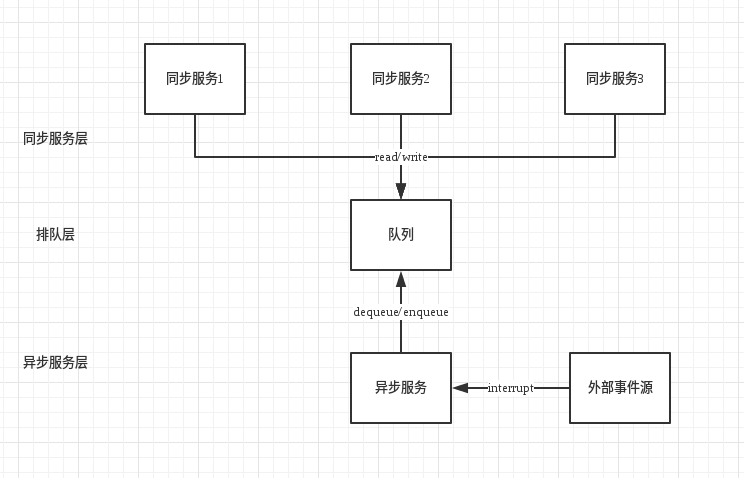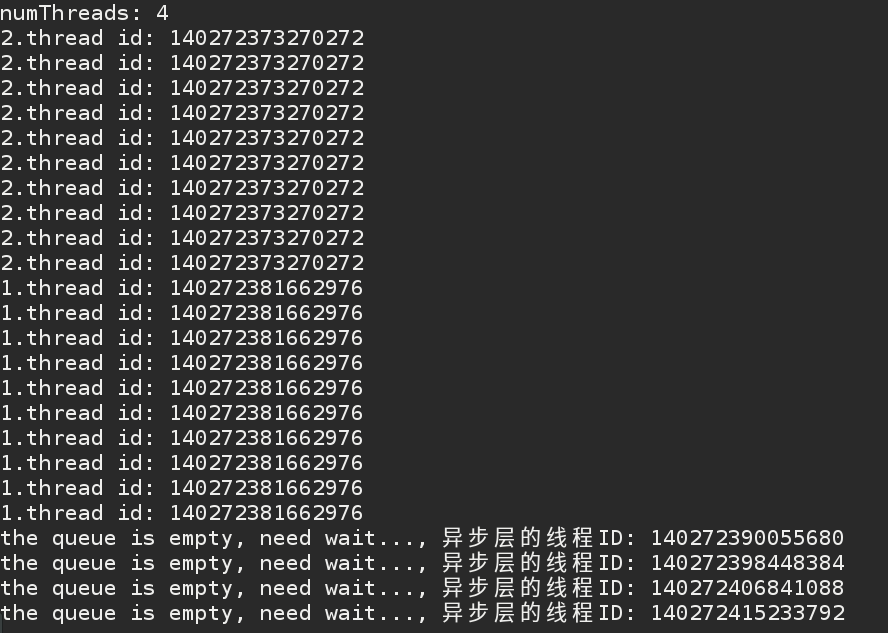c++11實現一個半同步半非同步執行緒池
阿新 • • 發佈:2019-01-07
在處理大量併發任務的時候,如果按照傳統的方式,一個請求一個執行緒來處理請求任務,大量的執行緒建立和銷燬將消耗過多的系統資源,還增加了執行緒上下文切換的開銷,而通過執行緒池技術就可以很好的解決這些問題,執行緒池技術通過在系統中預先建立一定數量的執行緒,當任務請求到來時從執行緒池中分配一個預先建立的執行緒去處理任務,執行緒在完成任務之後還可以重用,不會銷燬,而是等待下次任務的到來.
分層
半同步半非同步執行緒池分為三層:
同步服務層: 它處理來自上層的任務請求,上層的請求可能是併發的,這些請求不是馬上就會被處理的,而是將這些任務放到一個同步排隊層中,等待處理.
同步排隊層: 來自上層的任務請求都會加到排隊層中等待處理.
非同步服務層: 這一層中會有多個執行緒同時處理排隊層中的任務,非同步服務層從同步排隊層中取出任務並行的處理.
執行緒池實現
#include <list>
#include <mutex>
#include <thread>
#include <condition_variable>
#include <iostream>
#include <memory>
#include <atomic>
#include <functional>
using namespace std;
/********************************同步佇列******************************/ 物件池
物件池對於建立開銷較大的物件來說很有意義,為了避免重複建立開銷較大的物件,可以通過物件池來優化.
物件池的思路比較簡單,實現建立好一批物件,放到一個集合中,每當程式需要新的物件時,就從物件池中獲取,程式用完該物件後都會把該物件歸還給物件池.這樣會避免重複建立物件,提高程式效能.
#include <string>
#include <functional>
#include <memory>
#include <map>
using namespace std;
//要成為不可複製的類,典型的方法是將類的複製建構函式和賦值運算子設定為private或protected
//為了使ObjectPool為不可複製的類,我們定義了類NonCopyable,只需繼承起則可為不可複製的類
class NonCopyable
{
protected:
NonCopyable() = default;
~NonCopyable() = default;
NonCopyable(const NonCopyable&) = delete;
NonCopyable& operator =(const NonCopyable &) = delete;
};
//物件最大個數
const int MaxObjectNum = 10;
template <typename T>
class ObjectPool : NonCopyable
{
template <typename... Args>
using Constructor = function<shared_ptr<T> (Args...)>;
private:
//定義multimap型別的私有成員通過Constructor<Args...>型別獲得字串,則通過字串型別一對多的對應特定的物件.
multimap<string, shared_ptr<T>> m_object_map;
public:
//初始化建立物件
template <typename... Args>
void Init(size_t num, Args ...args)
{
if (num <= 0 || num > MaxObjectNum)
{
throw std::logic_error("Object num out of range");
}
//Init時的模板型別不同所得到的constructName字串不同
//所以相同的初始化型別對應m_object_map中的first相同,不同型別的則不同
auto constructName = typeid(Constructor<Args...>).name();
//cout << "Init: " << constructName << endl;
for (size_t i = 0; i < num; i++)
{
//刪除器中不直接刪除物件,而是回收到物件池中,以供下次使用
m_object_map.emplace(constructName,
shared_ptr<T>(new T(std::forward<Args>(args)...), [this, constructName](T *p)
{
cout << "dis: " << constructName << endl;
m_object_map.emplace(std::move(constructName),shared_ptr<T>(p));
}));
}
}
//從物件池獲取一個物件
template <typename... Args>
std::shared_ptr<T> Get()
{
string constructName = typeid(Constructor<Args...>).name();
cout << constructName << endl;
//通過Get的模板型別得到對應的字串,通過該字串找到所有該字串的對應
auto range = m_object_map.equal_range(constructName);
//從該型別對應的物件中獲取其中一個
for (auto it = range.first; it != range.second; it++)
{
auto ptr = it -> second;
m_object_map.erase(it);
return ptr;
}
return nullptr;
}
};

